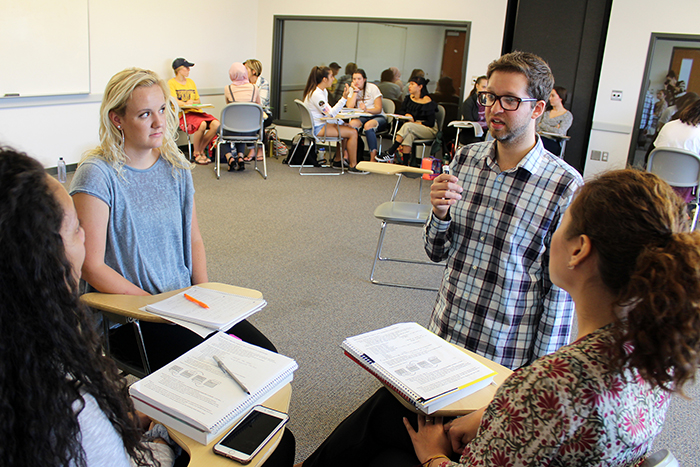Interrupting Self-Harm
 Sometimes you don’t choose what you do for a living. Sometimes it chooses you. Or
at least that’s how PhD student Michael Riquino feels. Why does he study self-harm
(what researchers refer to as nonsuicidal self-injury)? “It kept coming up, in everything
I did,” he said. Mr. Riquino has been working in the social work field ever since
he turned 18. From sexual assault crisis centers to substance use clinics; clients
facing effects of sexual trauma, violence, and neglect; adults and children; in legal,
medical, and educational settings – everywhere, he encountered people impacted by
self-harm. “I kept seeing this relationship: individuals who had experienced these
tremendously painful things were then causing themselves pain. And I wanted to try
and understand that.”
Sometimes you don’t choose what you do for a living. Sometimes it chooses you. Or
at least that’s how PhD student Michael Riquino feels. Why does he study self-harm
(what researchers refer to as nonsuicidal self-injury)? “It kept coming up, in everything
I did,” he said. Mr. Riquino has been working in the social work field ever since
he turned 18. From sexual assault crisis centers to substance use clinics; clients
facing effects of sexual trauma, violence, and neglect; adults and children; in legal,
medical, and educational settings – everywhere, he encountered people impacted by
self-harm. “I kept seeing this relationship: individuals who had experienced these
tremendously painful things were then causing themselves pain. And I wanted to try
and understand that.”
He’s seeking to do just that. Because there are not currently any treatments for self-harm that have been shown to be effective, Mr. Riquino was even more drawn to studying these issues when he entered the PhD Program. In crafting the research for his dissertation, he has been particularly interested in how to interrupt the psychological processes that lead to self-harm, as well as how to manage the distressing thoughts and emotions that may come up when teens are exposed to images or videos on social media of others engaging in self-harm.
“Michael's research is important because it addresses an unstudied risk factor for self-injury among youth – a growing public health concern,” said Associate Dean for Research Eric Garland, chair of Mr. Riquino’s committee. “Michael's study will be the first in the scientific literature to use a computerized attentional bias task to predict self-injury risk and to test whether a brief mindfulness intervention can reduce the severity of this risk factor.”
Current research shows that a third of teenagers intentionally hurt themselves – and some research studies suggest that up to half of teens in this country will intentionally hurt themselves at least once in a year. “That’s huge,” said Mr. Riquino. “That’s way too many kids who think they deserve to hurt themselves because they think they are bad or worthless, or who are trying to regulate distressing emotions and don’t have other ways to cope.” Research consistently shows the primary reason people engage in self-harm is for emotion regulation – a way to deal with the overwhelming emotions they’re feeling. Teenagers have a hypersensitive limbic system — the part of the brain responsible for managing and communicating about emotions. At a time of life when they have highly active limbic systems and are undergoing significant identity formation, teens are developmentally at a point when they feel things more deeply, but haven’t necessarily developed the skills to respond to those feelings.
He laments that many people continue to think teens engage in these behaviors for attention. This is rarely the case, he explains. Most often it’s about managing numbness, punishing oneself, or distracting oneself from distressing thoughts. As his clients often say, it’s easier to focus on the physical pain than the emotional pain – it gives the brain something else to fixate on. Those who experience marginalization or discrimination are even more likely to engage in self-harm.
“I am especially interested in what teenagers think needs to be done to address self-harm,” said Mr. Riquino. “We’ve spent a lot of time talking to adults and making hypotheses about what needs to be done, but we haven’t taken the time to just ask teenagers what they think needs to be done about an issue that is affecting them. And since teenagers are so creative, have so much insight, and really do know what’s going on, they can tell us some really significant stuff.” He says it’s especially important to him to talk with teens from marginalized groups that haven’t been asked before.
Mr. Riquino stressed that while the behavior is unhealthy or maladaptive, teens aren’t wrong or bad for engaging in self-harm. Rather, they can learn healthy ways of managing their distress. So much of these behaviors revolve around damaging views of self that it’s an important distinction to remember. Most of all, he wants people at risk of self-harm to believe they deserve something better for themselves. “Everyone deserves to treat themselves with kindness,” he said.
Mr. Riquino’s research is ongoing and he is currently recruiting study participants ages 12-24. To learn more about his Interrupting Self-Harm Study, visit: https://www.ishstudy.com/.
